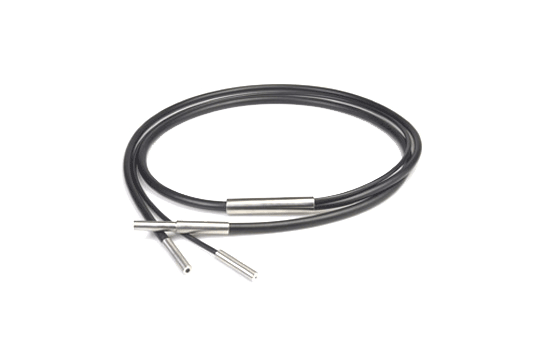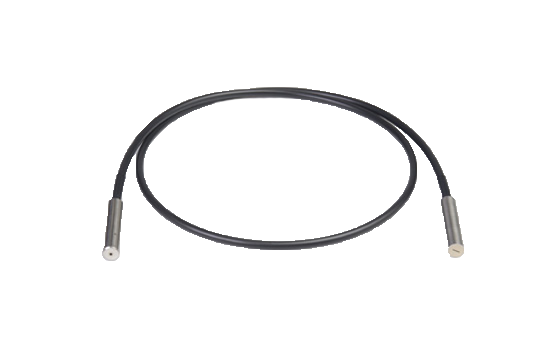Single Fiber Bundle
Single Fiber bundles are used for in-situ measurements where one bundle brings to the sample the excitation light and a second bundle collects the fluorescence light and diverts it back to the fluorometer detection channel. Compatible with ChronosBH, ChronosDFD, and PC1.Bifurcated Fiber Bundle

Chemically Activated Fiber Tip
The fiber optics sensor (FOS), or chemically-activated fiber tip, allows for the measurement to be performed in-situ, which is particularly of interest when the sample to be monitored is remote or is embedded in hazardous conditions (high temperature, toxic, flammable, high voltage, etc...). The accessory can be used to detect the presence of specific molecules inside the body (endoscope), to detect the presence of molecules in bioreactors, or to map the concentration of environmentally sensitive molecular complexes at different depths of the ocean.
The device consists of a fiber that channels using proper optics, the light produced by the spectrofluorometer's laser and carries it to the other end of the fiber, where a specific fluorophore is embedded in a polymeric matrix. The light excites the fluorophore; a portion of fluorescence is carried back through the same fiber to the instrument that monitors its properties (intensity or decay times).
The fiber of about 100 µm in diameter can be up to 250 m long.

Product Specifications for Fiber Optics
Single Fiber Optic Bundle
Total Number of Fibers
- To be Specified by Customer
Fiber Core Diameter
- 150 µm
Fiber Type
- Silica Core/Silica Clad
Operating Wavelength Range
- 360 - 700 nm
Fiber Numerical Aperture
- 0.22
Fiber Bundle
- Termination: Ferrule
- Diameter: 2 mm
Excitation Leg Configuration
- Round: Total diameter of the fibers is about 2 mm
Collecting Leg Configuration
- Round: The fibers going to the collection leg are randomly mixed with fibers coming from the excitation leg
Length (cm)
- 180
Sheathing
- Standard Cabling
Bifurcated Fiber Optics
Total Number of Fibers
- To be Specified by Customer
Fiber Core Diameter
- 150 µm
Fiber Type
- Silica Core/Silica Clad
Operating Wavelength Range
- 360 - 700 nm
Fiber Numerical Aperture
- 0.22
Common Leg Termination
- Ferrule (10 mm x 25 mm long)
Common Leg Configuration
- Round:
- Total diameter
- Patterns:
- Excitation in the middle and emission on the outside ring
- Excitation and emission randomly mixed with the collecting fibers
Excitation Leg Configuration
- Round: Total diameter of the fibers is about 2 mm
Collecting Leg Configuration
- Round: The fibers going to the collection leg are randomly mixed with fibers coming from the excitation leg
Total Length of Assembly
- 1.8 m
Length of Common End (without the bifurcation)
- 1.4 m
Sheathing
- Standard Cabling
Chemically Activated Fiber Tip and Fiber Optics
Objective
- Model LUCPlan FLN 20x/0.45 NA (by Olympus)
- Any RMS-thread objective
Positioning Stage
- 0.3 mm overall adjustment
Aligning Fiber
- 0.2 m graded index 62.5 µm Multimode Patch Cable (FC connector)
Product Resources
-
“Chapter 15 Instrumentation for Fluorescence-Based Fiber Optic Biosensors.” Thompson, R.B., Zeng, H.-H., Ohnemus, D., Mccranor, B., Cramer, M. & Moffett, J. Fluorescence Spectroscopy, pp. 311–337, 2008. doi: 10.1016/s0076-6879(08)03415-0.
-
“Real-Time Determination of Picomolar Free Cu(II) in Seawater Using a Fluorescence-Based Fiber Optic Biosensor.” Zeng, H.-H., Thompson, R.B., Maliwal, B.P., Fones, G.R., Moffett, J.W. & Fierke, C.A. Analytical Chemistry, 75(24), pp. 6807–6812, 2003, Nov. doi: 10.1021/ac0345401.



